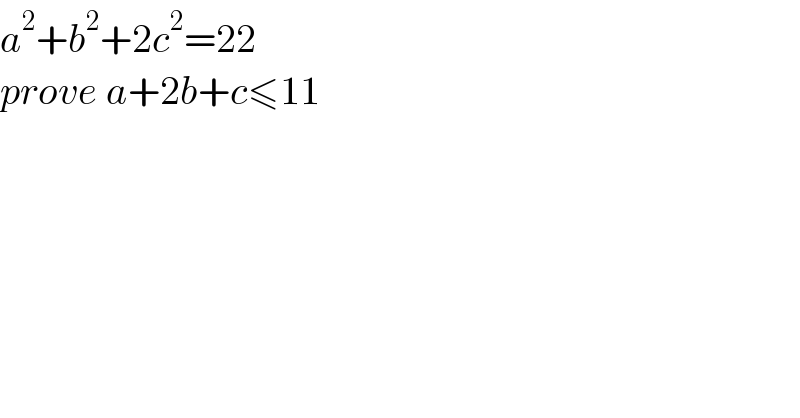
Question Number 203933 by liuxinnan last updated on 02/Feb/24

$${a}^{\mathrm{2}} +{b}^{\mathrm{2}} +\mathrm{2}{c}^{\mathrm{2}} =\mathrm{22} \\ $$$${prove}\:{a}+\mathrm{2}{b}+{c}\leqslant\mathrm{11} \\ $$
Answered by York12 last updated on 02/Feb/24

$$\left({a}+\mathrm{2}{b}+{c}\right)^{\mathrm{2}} \overset{{C}−\mathrm{S}} {\leqslant}\left({a}^{\mathrm{2}} +{b}^{\mathrm{2}} +\mathrm{2}{c}^{\mathrm{2}} \right)\left(\mathrm{1}+\mathrm{4}+\frac{\mathrm{1}}{\mathrm{2}}\right)=\mathrm{121} \\ $$$$\Leftrightarrow{a}+\mathrm{2}{b}+{c}\leqslant\mathrm{11}. \\ $$
Answered by witcher3 last updated on 02/Feb/24

$$\mathrm{a}+\mathrm{2b}+\mathrm{c}−\gamma\left(\mathrm{a}^{\mathrm{2}} +\mathrm{b}^{\mathrm{2}} +\mathrm{2c}^{\mathrm{2}} −\mathrm{22}\right)=\mathrm{f}\left(\mathrm{a},\mathrm{b},\mathrm{c},\gamma\right) \\ $$$$\partial_{\mathrm{a}} \mathrm{f}=\mathrm{0}\Rightarrow\mathrm{1}−\mathrm{2}\gamma\mathrm{a}=\mathrm{0} \\ $$$$\partial_{\mathrm{b}} \mathrm{f}=\mathrm{0}\Rightarrow\mathrm{2}−\mathrm{2}\gamma\mathrm{b}=\mathrm{0} \\ $$$$\partial_{\mathrm{c}} \mathrm{f}=\mathrm{0}\Rightarrow\mathrm{1}−\mathrm{4c}\gamma=\mathrm{0} \\ $$$$\Rightarrow\mathrm{c}=\frac{\mathrm{1}}{\mathrm{4}\gamma},\mathrm{b}=\frac{\mathrm{1}}{\gamma},\mathrm{a}=\frac{\mathrm{1}}{\mathrm{2}\gamma} \\ $$$$\partial\gamma=\mathrm{0}\Rightarrow\mathrm{a}^{\mathrm{2}} +\mathrm{b}^{\mathrm{2}} +\mathrm{2c}^{\mathrm{2}} −\mathrm{22}=\mathrm{0} \\ $$$$\Rightarrow\frac{\mathrm{1}}{\mathrm{4}}+\mathrm{1}+\frac{\mathrm{1}}{\mathrm{8}}−\mathrm{22}\gamma^{\mathrm{2}} =\mathrm{0} \\ $$$$\mathrm{22}\gamma^{\mathrm{2}} =\frac{\mathrm{11}}{\mathrm{8}}\Rightarrow\gamma=\underset{−} {+}\frac{\mathrm{1}}{\mathrm{4}} \\ $$$$\gamma=\frac{\mathrm{1}}{\mathrm{4}}\Rightarrow\mathrm{c}=\mathrm{1},\mathrm{b}=\mathrm{4},\mathrm{a}=\mathrm{2} \\ $$$$;\mathrm{f}\left(\mathrm{a},\mathrm{b},\mathrm{c},\gamma\right)\leqslant\mathrm{f}\left(\mathrm{2},\mathrm{4},\mathrm{1},\frac{\mathrm{1}}{\mathrm{4}}\right)=\mathrm{2}+\mathrm{8}+\mathrm{1}=\mathrm{11} \\ $$$$ \\ $$$$ \\ $$$$ \\ $$
Commented by York12 last updated on 02/Feb/24

$$\mathrm{is}\:\mathrm{not}\:\mathrm{that}\:\mathrm{lagrange}\:\mathrm{multipliers} \\ $$
Commented by witcher3 last updated on 04/Feb/24

$$\mathrm{yes}\: \\ $$
Commented by York12 last updated on 04/Feb/24

$$\mathrm{great} \\ $$
